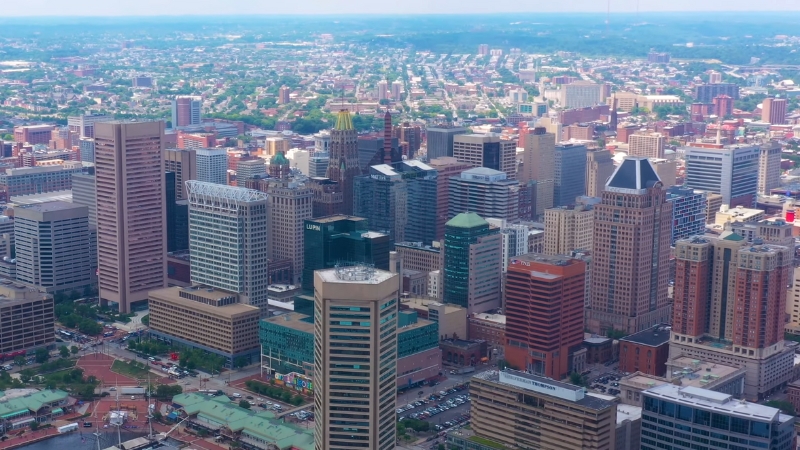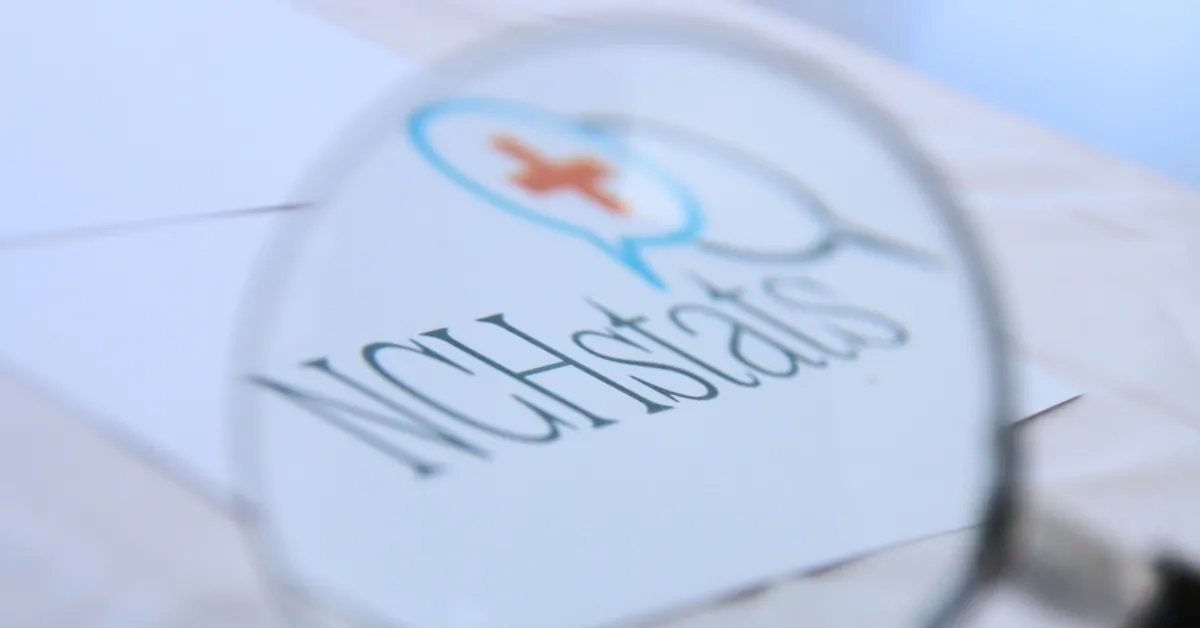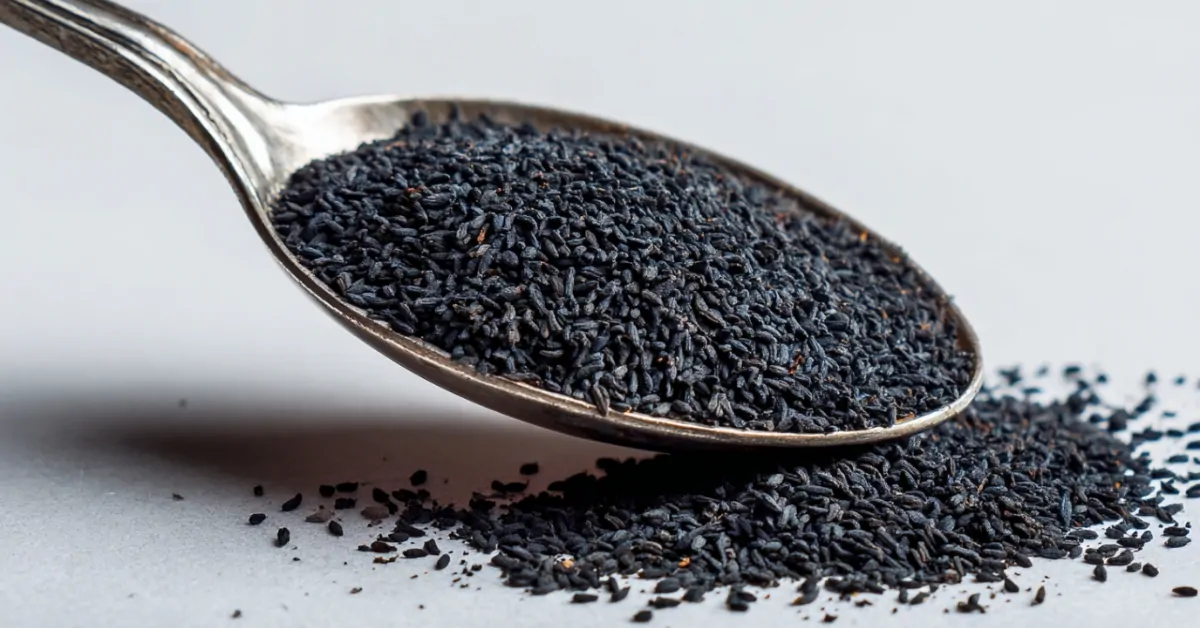As of 2025, the U.S. Census Bureau estimated Baltimore’s population to be 565,239, reflecting a 3.5% decrease from the 2020 census figure of 585,708 according to Census.gov.
In 2025, Baltimore’s metro area population is projected to be approximately 2,387,000, reflecting a modest growth of 0.72% from the previous year as noted by Macrotrends.
This data points to underlying trends in urban development and demographic changes within the region.
Table of Contents
ToggleKey Takeaways
Population Growth and Historical Significance
In 2011, Baltimore experienced its first population growth in 60 years after previously losing over one-third of its residents. Like many cities with economies rooted in outdated industries, Baltimore has faced challenges in attracting and retaining citizens. However, it has gained popularity among younger generations, as noted by one demographer.
This reversal of a six-decade population decline coincided with Maryland gaining new residents in 17 counties, including Baltimore City. The mayor’s initiatives to encourage Hispanic immigration have contributed to the growth, with immigrants being a significant factor in the population increase, albeit by less than 1%.
Baltimore, named after Cecilius Calvert, Lord Baltimore, the founding proprietor of the Maryland Colony, has a rich history. The Port of Baltimore, established in 1706 for the tobacco trade, led to the town’s founding in 1729. The city played a central role during the American Revolution and even served as the U.S. capital from December 1776 to February 1777.
During the War of 1812, the Battle of Baltimore occurred after Washington, D.C., was burned. The British attack in 1814 was successfully repelled, with Baltimore’s harbor playing a key defensive role.
Francis Scott Key, a Maryland lawyer, witnessed the assault while negotiating aboard a British ship for a prisoner’s release. Seeing the massive American flag raised the next morning inspired him to write “The Star-Spangled Banner,” later designated the national anthem in 1931.
Age Distribution
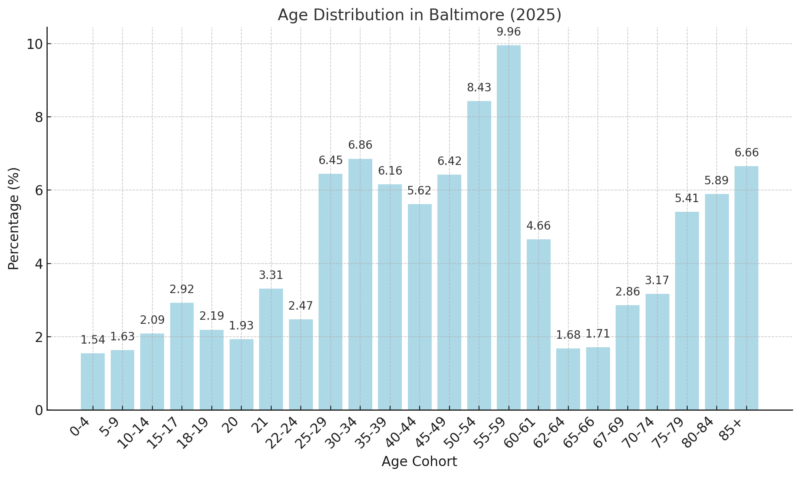
The largest proportions of Baltimore’s population are in the middle-aged and older adult categories, particularly the 55-59 cohort, which represents 9.96% of the total. Young adults aged 25-34 are also well-represented, with a combined percentage of 13.31% as noted by Statistical Atlas.
The smaller percentages among younger children and teenagers indicate a declining youth population, which may be due to migration patterns or declining birth rates. The steady increase in percentages for older cohorts suggests an aging population.
Age and Sex Distribution
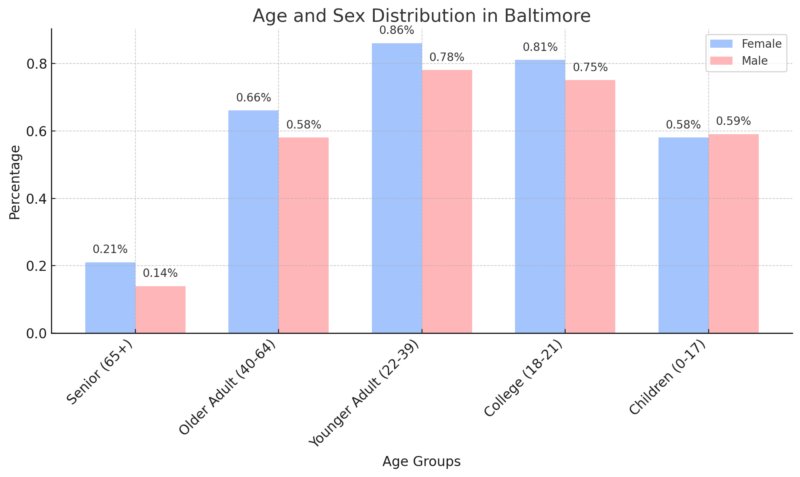
Older adults (40-64) make up the largest share of Baltimore’s population, reflecting the aging trend observed in Table 1. Younger adults (22-39) form the next largest category, showing a relatively balanced distribution between males and females.
Children under 17 represent a significant portion of the population (21.1%), indicating the need for continued investment in education and youth services. Seniors (65+) have a smaller but notable share, which aligns with the aging population trend.
Detailed Age and Sex Distribution
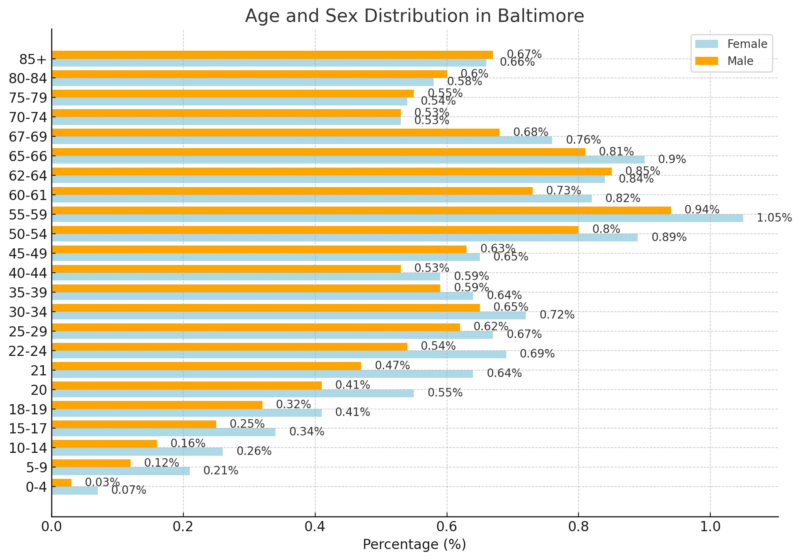
The detailed breakdown shows that females generally outnumber males in most cohorts, particularly in older age groups (e.g., 55-59 and 65-66). This is consistent with national trends where women tend to have a higher life expectancy than men.
The younger cohorts (0-4 and 5-9) show a smaller gender gap. The largest gender differences appear in the 55-59 cohort, suggesting the effects of aging and mortality rates are more pronounced for male.
Ethnic and Racial Composition
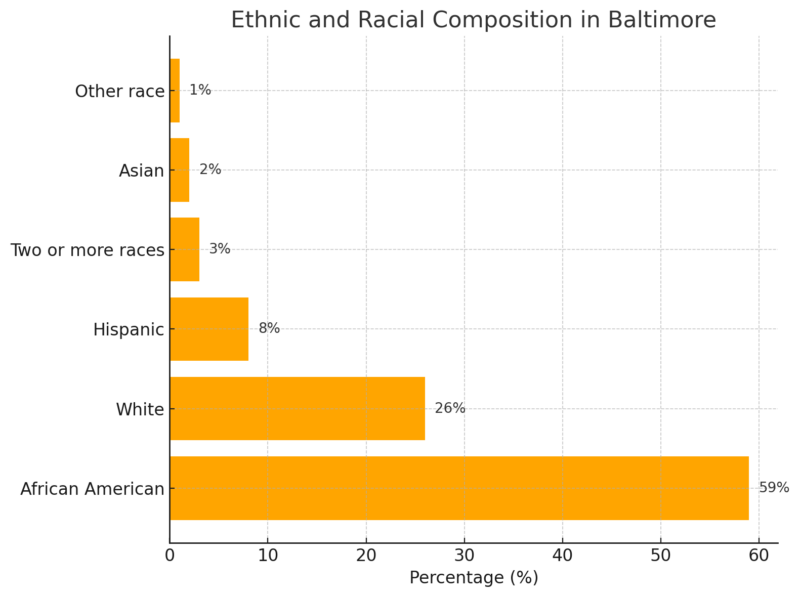
Baltimore City’s population is predominantly African American, making up 59% of the population, which highlights the city’s historical and cultural significance for the Black community according to Niche.
White residents are the second-largest group at 26%.
Hispanic individuals, while comprising a smaller share (8%), represent a growing demographic in the city, reflecting recent immigration trends.
The presence of individuals identifying as two or more races (3%) and Asian (2%) demonstrates increasing diversity.
The “Other race” category (1%) represents the smallest portion, likely including smaller minority groups and individuals who do not identify with the major racial categories.
Income Levels
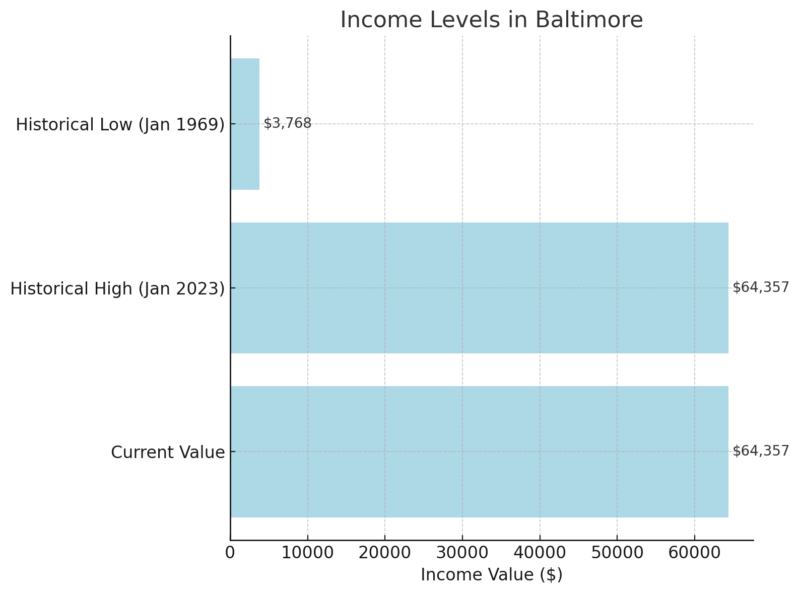
Baltimore’s per capita personal income reached a historic high of $64,357 in January 2023, reflecting significant economic growth over decades. However, disparities in income distribution suggest that the benefits of this growth are not evenly shared across the population according to Trading Economics.
The contrast with the 1969 low of $3,768 highlights a long-term upward trend, but the income growth is not sufficient to address current affordability challenges for low-wage workers.
Minimum Wage
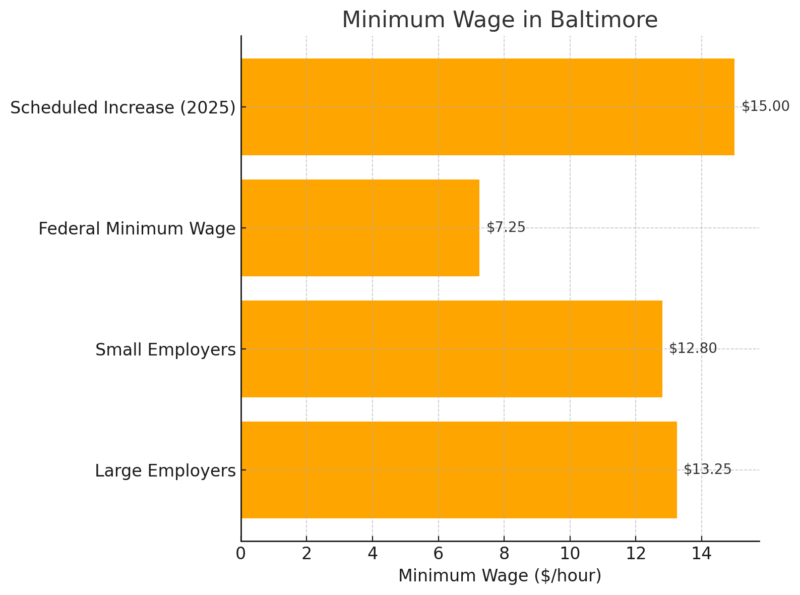
Baltimore’s minimum wage, currently set at $13.25 for large employers and $12.80 for small employers, exceeds the federal minimum of $7.25 but falls short of the living wage requirements as noted by Workstream.
The scheduled increase to $15.00 by 2025 is a positive step but may still lag behind rising costs of living.
Many workers, especially those in low-wage sectors, continue to face economic hardships, highlighting the need for further wage policy reforms.
Living Wage
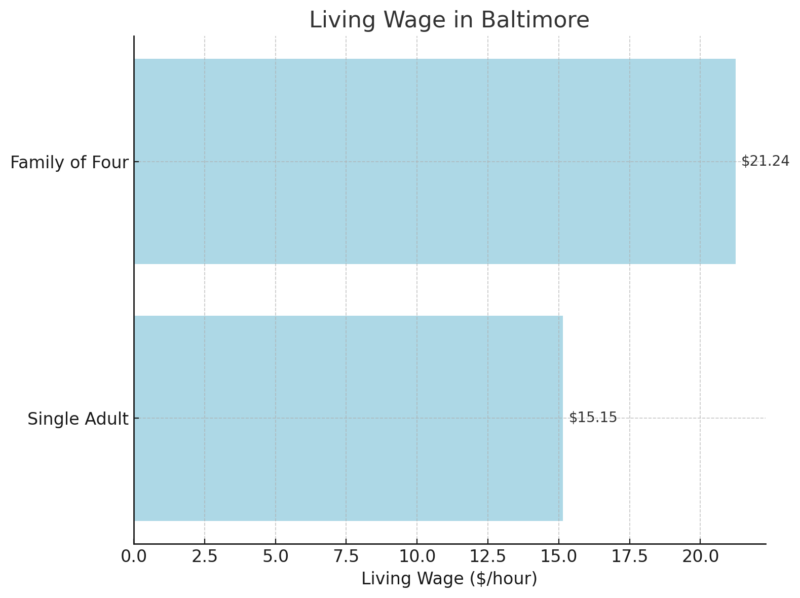
The living wage in Baltimore, calculated at $15.15 per hour for a single adult and $21.24 for a family of four, exceeds the current minimum wage.
This indicates a gap between what workers earn and what is required to meet basic needs, such as housing, food, and transportation.
Bridging this gap is essential for reducing poverty and ensuring economic stability for low-income households.
Worker Statistics Below Living Wage
Metric
Value
Workers Below Living Wage
63,000
Approximately 63,000 workers in Baltimore earn less than a living wage, disproportionately affecting women, people of color, and immigrants.
These individuals often work in low-wage industries such as retail, food service, and hospitality, which offer limited financial security.
Addressing this issue requires targeted efforts, such as raising the minimum wage, supporting workforce development, and promoting higher-paying job opportunities.
Baltimore City Council to consider raising minimum wage for tipped workers https://t.co/guHhGlgYFC
— The Baltimore Sun (@baltimoresun) June 28, 2024
Employment Rates
Metric
Value
Total Nonfarm Employment
1,420,800 jobs
Change in Employment (Aug 2023-24)
+400 jobs (0.0%)
Leading Sector Growth
Education and Health Services (+8,100 jobs, +3.0%)
Declining Sectors
Trade, Transportation, and Utilities (-4,300 jobs, -1.7%)
Government
-3,500 jobs (-1.5%)
The Baltimore metropolitan area saw minimal net job growth over the year (+400 jobs).
The education and health services sector was the standout, with a 3.0% increase, adding 8,100 jobs according to BLS.
However, sectors such as trade, transportation, and utilities and government experienced declines, pulling down overall growth.
The slight 0.0% growth rate is below the national average of 1.5%, signaling regional economic stagnation compared to broader trends.
Baltimore City Employment Trends
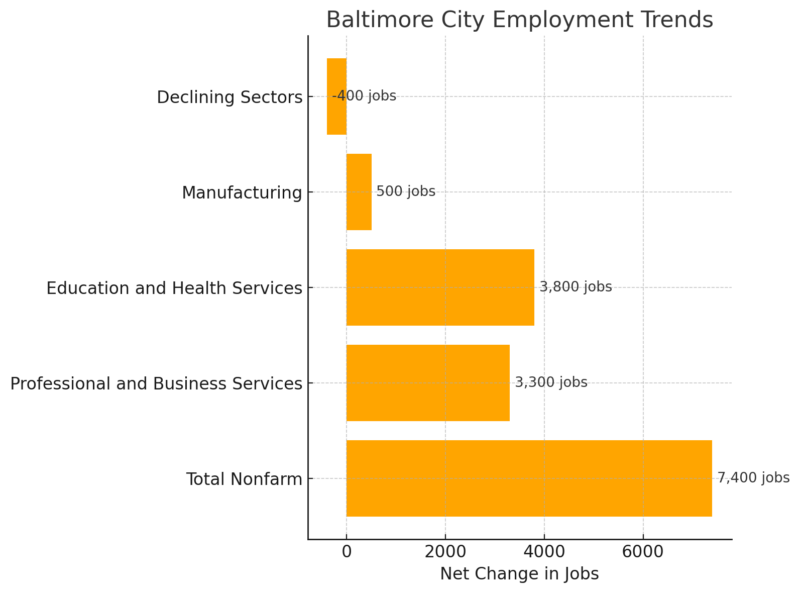
Baltimore City outpaced the larger metropolitan area with a 2.0% increase in total nonfarm employment.
Strong growth in professional and business services (+5.7%) and education and health services (+3.3%) highlights the city’s ongoing shift toward knowledge-based and healthcare industries.
Conversely, the decline in mining, logging, and construction reflects challenges in traditional labor-intensive industries.
National vs. Regional Comparison (August 2024)
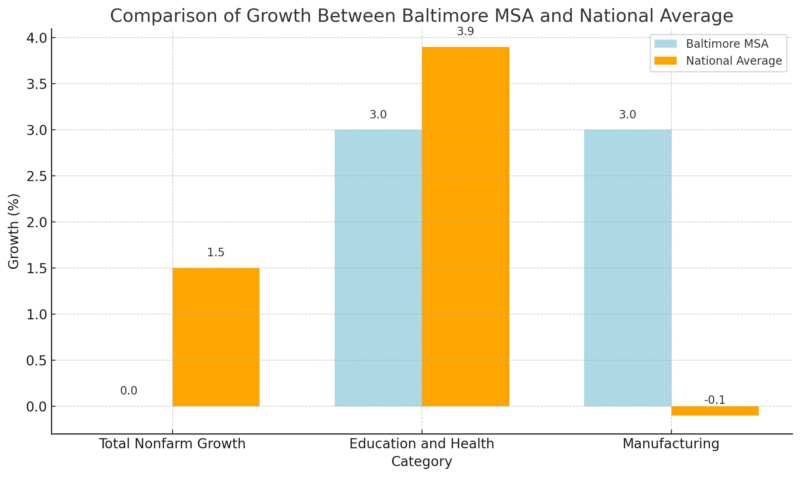
The Baltimore metropolitan area lags behind the national average in overall job growth (0.0% vs. 1.5%).
However, its manufacturing sector grew by 3.0%, outperforming the national decline of -0.1%.
Education and health services also showed robust local growth but trailed national rates, suggesting room for further expansion in these key sectors.
Education Attainment
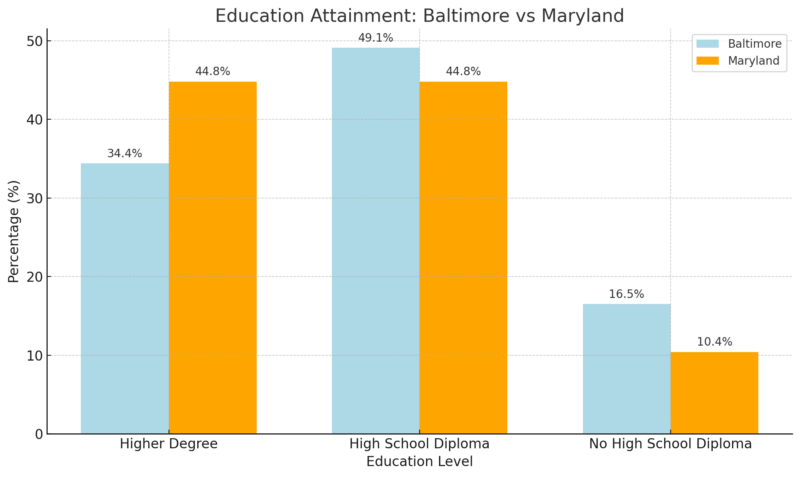
Statistical Atlas shows that Baltimore has a lower proportion of individuals with a higher degree (34.4%) compared to Maryland as a whole (44.8%), suggesting a gap in advanced educational attainment.
However, the city has a higher percentage of residents with only a high school diploma (49.1%) compared to the state average (44.8%), indicating a concentration of mid-level educational achievement.
The percentage of residents without a high school diploma is also significantly higher in Baltimore (16.5%) compared to Maryland (10.4%), reflecting challenges in educational access and retention.
Relative Educational Attainment (Baltimore vs. Maryland)
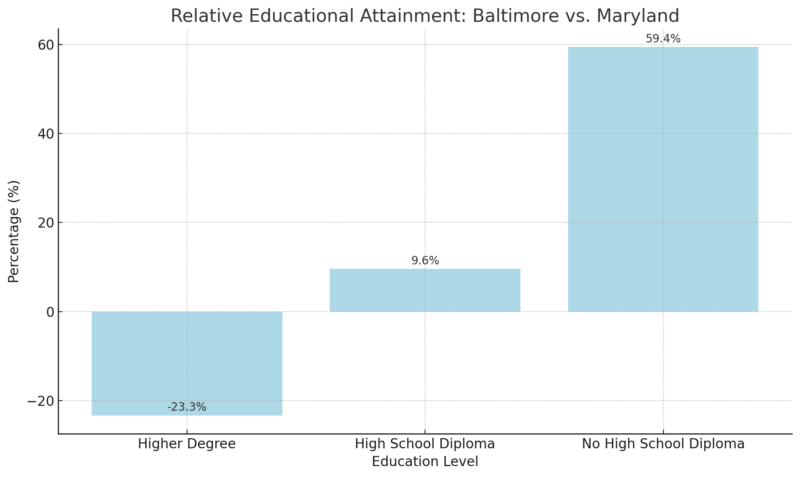
Baltimore’s educational attainment differs significantly from Maryland’s averages.
The city has 23.3% fewer residents with higher degrees compared to the state, highlighting a notable disparity in advanced education levels.
Conversely, Baltimore has 9.6% more residents with only a high school diploma and 59.4% more residents without a high school diploma, emphasizing a greater need for investment in educational programs, vocational training, and dropout prevention initiatives to bridge these gaps.
Baltimore Housing Market Overview
Metric
Value
Total Neighborhoods
233
Homes for Sale
9,901
Price Range of Homes
$1,000 – $4.3 million
Median Listing Home Price
$225,000
Median Price per Square Foot
$161
Median Sold Home Price
$210,500
Baltimore’s housing market is characterized by a wide range of options, with homes priced between $1,000 and $4.3 million. The median listing price of $225,000 and the median sold price of $210,500 reflect the city’s overall affordability compared to many other urban areas as noted by the Realtor.
At $161 per square foot, Baltimore offers relatively competitive housing costs, which can attract both first-time homebuyers and investors. Neighborhood-specific factors such as amenities, safety, and schools heavily influence these metrics.
Best Neighborhoods in Baltimore
Neighborhood
Key Highlights
Canton
Known for its waterfront views and trendy spots.
Frankford
Offers a suburban feel with access to amenities.
Belair-Edison
Family-friendly and known for its affordability.
Canton, Frankford, and Belair-Edison are considered some of the best neighborhoods in Baltimore.
Canton stands out for its vibrant atmosphere and proximity to the waterfront, making it ideal for professionals and families who value urban living.
Frankford offers a quieter, suburban lifestyle, while Belair-Edison is popular for its affordability and community-oriented environment.
Foreign-Born Population in Baltimore, Maryland
Metric
Baltimore
Maryland
Children with at least one immigrant parent
114,500 (1 in 5)
363,300 (1 in 4)
Percentage of these children who are U.S. citizens
Vast majority
Vast majority
Non-citizens at risk of deportation
135,600
453,900
Children with immigrant parents make up a significant share of both Baltimore’s and Maryland’s populations, highlighting the importance of immigrants to family structures and community stability.
However, 135,600 non-citizens in Baltimore are at risk of deportation, creating challenges for mixed-status families and adding to uncertainties for many households as noted by Vera-institute.
Local Community Ties
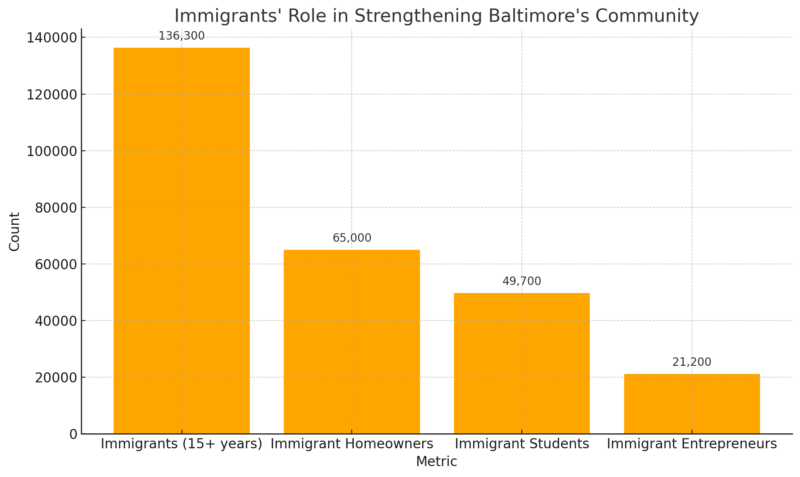
Immigrants in Baltimore have strong community ties, with many having lived in the U.S. for over 15 years.
They are active participants in local education systems and business development, with nearly 50,000 immigrant students and over 21,000 entrepreneurs contributing to the city’s economic and social fabric.
Immigrant Population
Metric
Baltimore
Maryland
Immigrant population
292,100 (10% of total pop.)
921,900 (15% of total pop.)
Share of U.S.-born children with immigrant parents
Vast majority
Vast majority
Immigrants constitute 10% of Baltimore’s population and 15% of Maryland’s, representing a diverse and integral part of the community.
Their contributions go beyond numbers, influencing culture, business, and family dynamics in both the city and state.
Economic and Labor Force Contributions
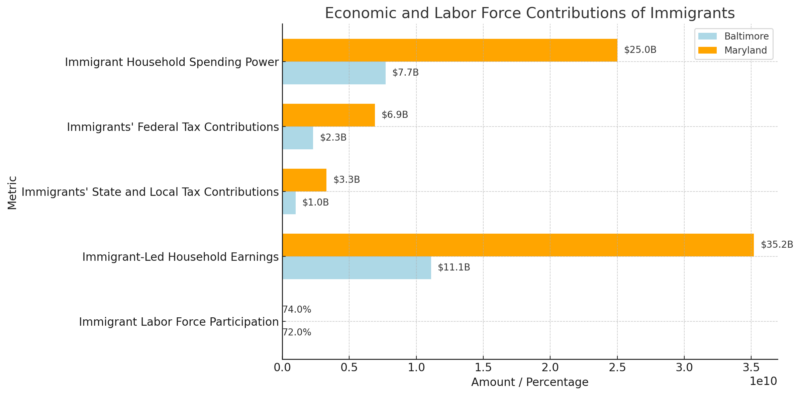
Immigrants play a crucial role in Baltimore’s and Maryland’s economies.
In Baltimore, immigrant labor force participation (72%) exceeds that of native-born residents (67%), underscoring their importance in the workforce.
Immigrant-led households contribute billions in taxes and possess substantial spending power, which supports local and state economies.
Methodology
This article synthesizes information from authoritative sources, including the U.S. Census Bureau, Bureau of Labor Statistics, and economic data aggregators. Data was analyzed to highlight population trends, economic contributions, and demographic insights.
Sector-specific growth and housing affordability were evaluated using regional and national benchmarks. Educational and labor force statistics were cross-referenced to ensure accuracy and context.
Finally, actionable insights were derived to present a concise profile of Baltimore’s socio-economic landscape.
References
- U.S. Census Bureau – QuickFacts: Baltimore City, Maryland
- Macrotrends – Baltimore Metro Area Population
- Statistical Atlas – Age and Sex: Baltimore City
- Niche – Baltimore, MD: Residents
- Trading Economics – Baltimore City, MD – Per Capita Personal Income
- Workstream – Minimum Wage in Baltimore, Maryland
- Realtor – Baltimore, MD Real Estate Market Overview
- Vera Institute of Justice – Profile of the Foreign-Born Population in Baltimore, Maryland
- Bureau of Labor Statistics (BLS) – Baltimore Area Employment—August 2024
- New American Economy (NAE) – Immigrants and the Economy in Baltimore


